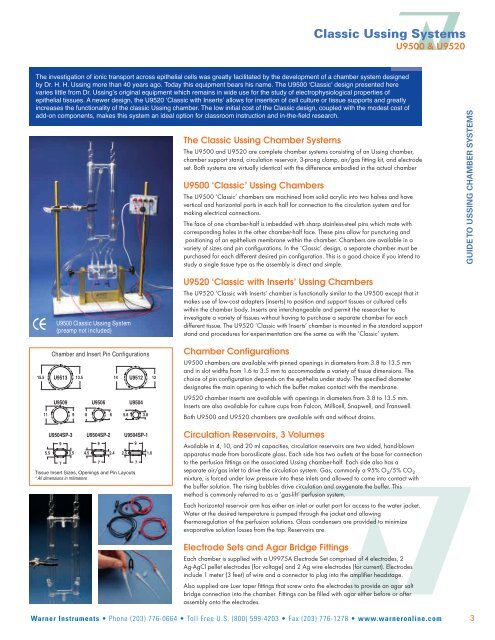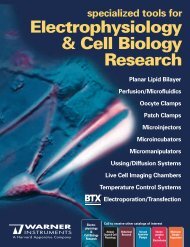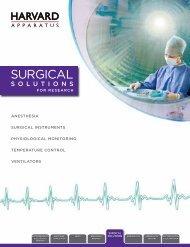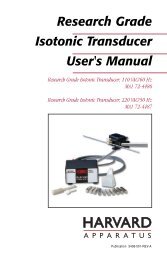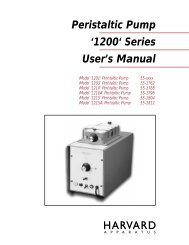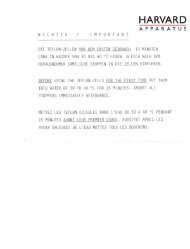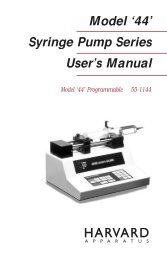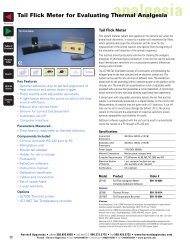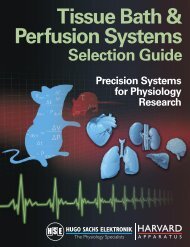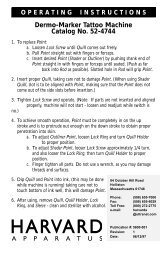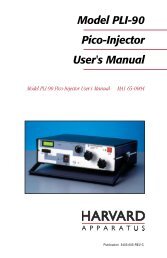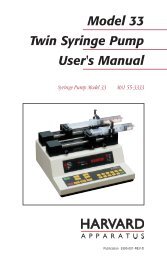Guide to Ussing Chamber Systems - Harvard Apparatus
Guide to Ussing Chamber Systems - Harvard Apparatus
Guide to Ussing Chamber Systems - Harvard Apparatus
You also want an ePaper? Increase the reach of your titles
YUMPU automatically turns print PDFs into web optimized ePapers that Google loves.
Classic <strong>Ussing</strong> <strong>Systems</strong><br />
U9500 & U9520<br />
The investigation of ionic transport across epithelial cells was greatly facilitated by the development of a chamber system designed<br />
by Dr. H. H. <strong>Ussing</strong> more than 40 years ago. Today this equipment bears his name. The U9500 ʻClassicʼ design presented here<br />
varies little from Dr. <strong>Ussing</strong>ʼs original equipment which remains in wide use for the study of electrophysiological properties of<br />
epithelial tissues. A newer design, the U9520 ʻClassic with Insertsʼ allows for insertion of cell culture or tissue supports and greatly<br />
increases the functionality of the classic <strong>Ussing</strong> chamber. The low initial cost of the Classic design, coupled with the modest cost of<br />
add-on components, makes this system an ideal option for classroom instruction and in-the-field research.<br />
U9500 Classic <strong>Ussing</strong> System<br />
(preamp not included)<br />
<strong>Chamber</strong> and Insert Pin Configurations<br />
Tissue Insert Sizes, Openings and Pin Layouts<br />
* All dimensions in milimeters<br />
The Classic <strong>Ussing</strong> <strong>Chamber</strong> <strong>Systems</strong><br />
The U9500 and U9520 are complete chamber systems consisting of an <strong>Ussing</strong> chamber,<br />
chamber support stand, circulation reservoir, 3-prong clamp, air/gas fitting kit, and electrode<br />
set. Both systems are virtually identical with the difference embodied in the actual chamber<br />
U9500 ‘Classic’ <strong>Ussing</strong> <strong>Chamber</strong>s<br />
The U9500 ‘Classic’ chambers are machined from solid acrylic in<strong>to</strong> two halves and have<br />
vertical and horizontal ports in each half for connection <strong>to</strong> the circulation system and for<br />
making electrical connections.<br />
The face of one chamber-half is imbedded with sharp stainless-steel pins which mate with<br />
corresponding holes in the other chamber-half face. These pins allow for puncturing and<br />
positioning of an epithelium membrane within the chamber. <strong>Chamber</strong>s are available in a<br />
variety of sizes and pin configurations. In the ‘Classic’ design, a separate chamber must be<br />
purchased for each different desired pin configuration. This is a good choice if you intend <strong>to</strong><br />
study a single tissue type as the assembly is direct and simple.<br />
U9520 ‘Classic with Inserts’ <strong>Ussing</strong> <strong>Chamber</strong>s<br />
The U9520 ‘Classic with Inserts’ chamber is functionally similar <strong>to</strong> the U9500 except that it<br />
makes use of low-cost adapters (inserts) <strong>to</strong> position and support tissues or cultured cells<br />
within the chamber body. Inserts are interchangeable and permit the researcher <strong>to</strong><br />
investigate a variety of tissues without having <strong>to</strong> purchase a separate chamber for each<br />
different tissue. The U9520 ‘Classic with Inserts’ chamber is mounted in the standard support<br />
stand and procedures for experimentation are the same as with the ‘Classic’ system.<br />
<strong>Chamber</strong> Configurations<br />
U9500 chambers are available with pinned openings in diameters from 3.8 <strong>to</strong> 13.5 mm<br />
and in slot widths from 1.6 <strong>to</strong> 3.5 mm <strong>to</strong> accommodate a variety of tissue dimensions. The<br />
choice of pin configuration depends on the epithelia under study. The specified diameter<br />
designates the main opening <strong>to</strong> which the buffer makes contact with the membrane.<br />
U9520 chamber inserts are available with openings in diameters from 3.8 <strong>to</strong> 13.5 mm.<br />
Inserts are also available for culture cups from Falcon, Millicell, Snapwell, and Transwell.<br />
Both U9500 and U9520 chambers are available with and without drains.<br />
Circulation Reservoirs, 3 Volumes<br />
Available in 4, 10, and 20 ml capacities, circulation reservoirs are two sided, hand-blown<br />
apparatus made from borosilicate glass. Each side has two outlets at the base for connection<br />
<strong>to</strong> the perfusion fittings on the associated <strong>Ussing</strong> chamber-half. Each side also has a<br />
separate air/gas inlet <strong>to</strong> drive the circulation system. Gas, commonly a 95% O 2 /5% CO 2<br />
mixture, is forced under low pressure in<strong>to</strong> these inlets and allowed <strong>to</strong> come in<strong>to</strong> contact with<br />
the buffer solution. The rising bubbles drive circulation and oxygenate the buffer. This<br />
method is commonly referred <strong>to</strong> as a ‘gas-lift’ perfusion system.<br />
Each horizontal reservoir arm has either an inlet or outlet port for access <strong>to</strong> the water jacket.<br />
Water at the desired temperature is pumped through the jacket and allowing<br />
thermoregulation of the perfusion solutions. Glass condensers are provided <strong>to</strong> minimize<br />
evaporative solution losses from the <strong>to</strong>p. Reservoirs are.<br />
Electrode Sets and Agar Bridge Fittings<br />
Each chamber is supplied with a U9975A Electrode Set comprised of 4 electrodes, 2<br />
Ag-AgCl pellet electrodes (for voltage) and 2 Ag wire electrodes (for current). Electrodes<br />
include 1 meter (3 feet) of wire and a connec<strong>to</strong>r <strong>to</strong> plug in<strong>to</strong> the amplifier headstage.<br />
Also supplied are Luer taper fittings that screw on<strong>to</strong> the electrodes <strong>to</strong> provide an agar salt<br />
bridge connection in<strong>to</strong> the chamber. Fittings can be filled with agar either before or after<br />
assembly on<strong>to</strong> the electrodes.<br />
Warner Instruments • Phone (203) 776-0664 • Toll Free U.S. (800) 599-4203 • Fax (203) 776-1278 • www.warneronline.com<br />
USSING CHAMBER SYSTEMS<br />
3GUIDE TO


